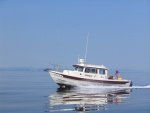I have had several large sailboats that I kept in the water at a marina. Dock rent was $200.00 each month. Some marinas charge much more. You have to also consider the haul out and bottom paint every other year. On the sailboat a trip from home to Panama City (60 miles) it took 11 hours. With my CD the trip is 3.5 hours.
Now I figure that if I buy $200.00 gas a month - "Whats the difference?"
I keep my CD on a trailer in my back yard. I can go sit in it and enjoy being there anytime. Some months I do not use the CD and some months I use it several times. For the entire year I do not burn the $2,400.00 that I would of spent on dock rent.
I usually cruise at 3400 rpm at a speed of 17 to 19 knots and use the trim tabs.
Now I figure that if I buy $200.00 gas a month - "Whats the difference?"
I keep my CD on a trailer in my back yard. I can go sit in it and enjoy being there anytime. Some months I do not use the CD and some months I use it several times. For the entire year I do not burn the $2,400.00 that I would of spent on dock rent.
I usually cruise at 3400 rpm at a speed of 17 to 19 knots and use the trim tabs.

